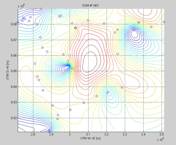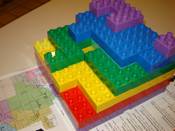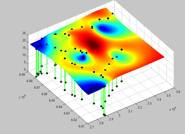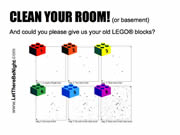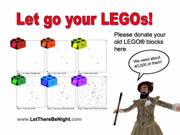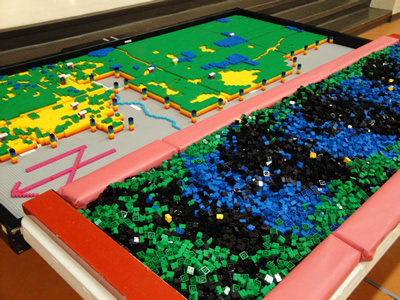 NOTE: The results of the science experiment are in. See the actual LEGO model at results.html. Below is a description of what we anticipated the model to look like.
NOTE: The results of the science experiment are in. See the actual LEGO model at results.html. Below is a description of what we anticipated the model to look like.
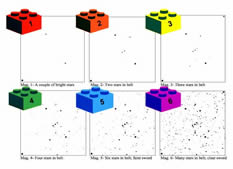 Q: By how much have we altered the night sky from its natural state?
Q: By how much have we altered the night sky from its natural state?
In a star hunt, observers seek faint stars to determine the limiting magnitude, the point where the faint stars start cutting out. Some observers estimate the sky brightness visually and suggest a limiting brightness from about 6 down to 1 (magnitudes). Others measure with Sky Quality Meters (SQMs) and suggest a sky glow from about 21 down to 16 (magnitudes per square arcsecond).
"Let Go of Your LEGOs": A campaign is underway at PHM Schools to collect thousands of LEGO® blocks so teams can build a model that shows how much of the night sky has been lost.
With stacks of building blocks, observers can plot their numbers on a grid to show the light levels across their community.![]() The stacks become a 3D map showing the loss of night sky from the ideal.
The stacks become a 3D map showing the loss of night sky from the ideal.
The 5-colored column at left shows a sample scale. Purple represents the magnitude of the pristine natural sky; red represents the magnitude of a heavily polluted night sky.
[Again, that magnitude could be the SQM reading (say, 21 down to 16) or the naked eye “reading” (6 down to 1). ]
To begin, show an ideal area with purple all the way across the grid.
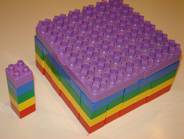
As you lose night, you remove top LEGO® blocks—say, one block for each magnitude (by SQM or naked eye) of night lost.
Introduce a pocket of development and you get sky glow. The purple gets pealed away as the pristine night lessens.
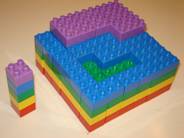
Urban sprawl creeps outward to the near corner, and the loss of night continues.
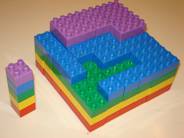
(The purple should be removed in the picture below, if not above.)
Eventually, you have no ideal sky, and areas like the near corner are doomed to have bright skies.
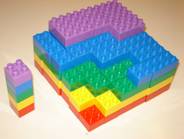
Another picture showing all of the blocks that you’ve removed would indicate how much sky you’ve lost. Or build the inverse or complementary stacks from the debris.
[If each block height represents a magnitude (2.5x), then 2.5 to the power of the number of blocks removed is how much sky you’ve lost from the pristine level. (Check the math, and the explanation).]
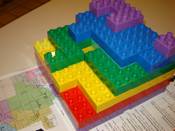
 Consider placing stacks directly on a community map, or stick into clear LEGO base that’s placed over map.
Consider placing stacks directly on a community map, or stick into clear LEGO base that’s placed over map.
![]()
 Reminder: For this LEGO grid, the color code is switched from Michael Warner’s formatted 3D grid so that purple is dark sky and red is bright sky. The LEGO block color scale does not extend far beyond the observed numbers. Order shown is R_YGB_V.
Reminder: For this LEGO grid, the color code is switched from Michael Warner’s formatted 3D grid so that purple is dark sky and red is bright sky. The LEGO block color scale does not extend far beyond the observed numbers. Order shown is R_YGB_V.
How much we’ve altered the night could also be represented in an art project. Make a candle with 5 layers of colors, as suggested at right. Then carve out the wax until it is comparable to the layering shown in the model LEGO block model.
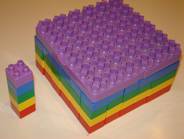 Between steps of colors would be slopes showing the gradual transition. The wax shavings that are removed would represent lost night sky. Gaps in observations would be holes in the building block grid, but they are smoothed over in the art. Or, instead of wax, start with a 5-colored block of modeling clay. Scrape away; interpolate with wax.
Between steps of colors would be slopes showing the gradual transition. The wax shavings that are removed would represent lost night sky. Gaps in observations would be holes in the building block grid, but they are smoothed over in the art. Or, instead of wax, start with a 5-colored block of modeling clay. Scrape away; interpolate with wax.
Compare the community’s digital 3D map (example by Michael Warner (MW), from Malcolm Smith paper, below) with the LEGO model, wax model, or clay model. So how much has the community lost?
Comparing LEGO block model (left) to computer generated model (right).
| Scale of the model |
|
|
| Overhead contour lines view. |
|
|
| 3D model |
|
|
LEGO Block Collection Campaign
Three new posters, below, are available for schools and other collection sites. LTBN student teams are gathering the blocks to make a 3-D model of the results.

